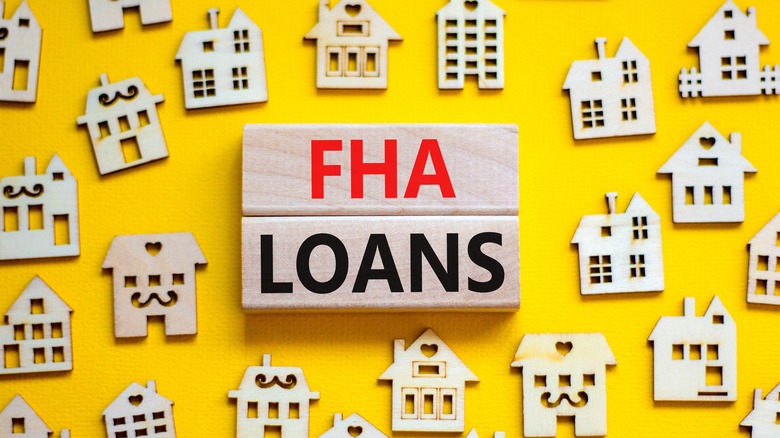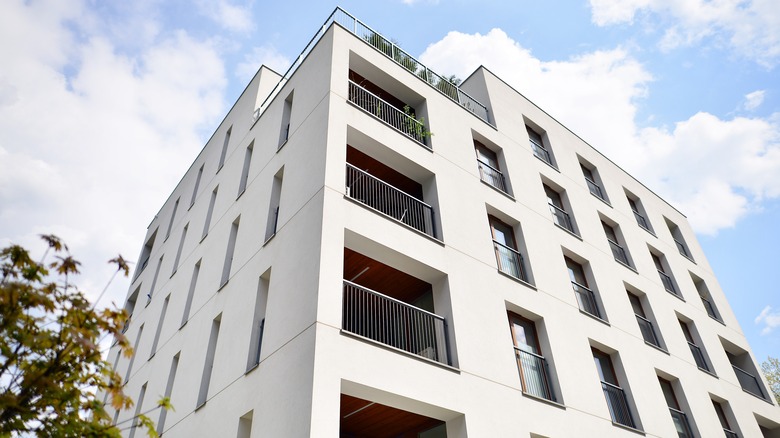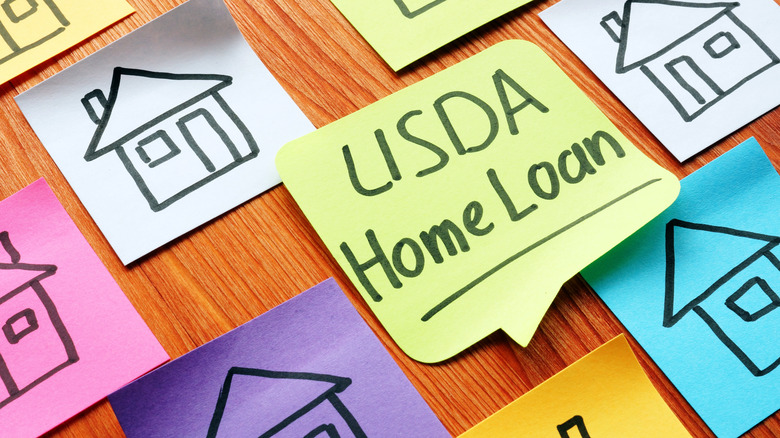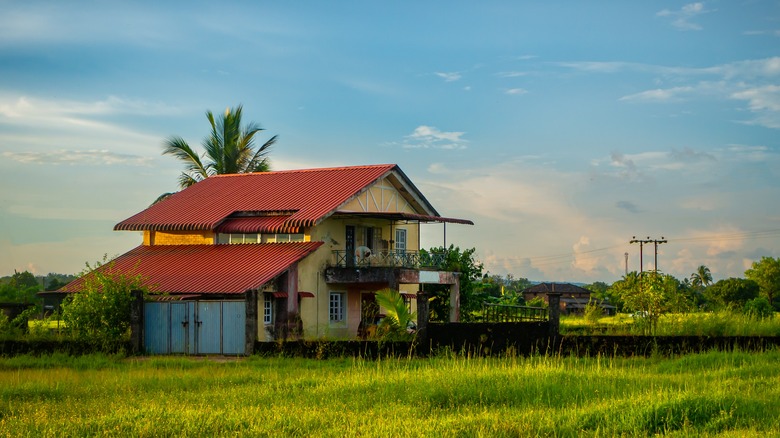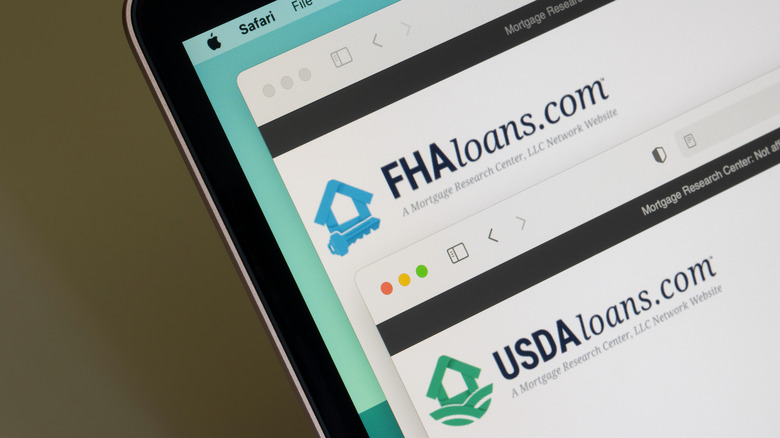FHA Vs. USDA Loans: Which Is Best For You?
Purchasing a home involves a lot of moving parts (pun intended). Unless you have an inheritance to blow or a C-suite-level job (in which case, you're killing it), you'll likely have to take out a loan to purchase said home. Besides figuring out logistics like where you want to live, the overall budget, and when to move, you'll also have to consider various loan options. This can feel confusing, especially with so many different rates, mortgage types, and lenders.
According to the U.S. Census Bureau, the average mortgage loan amount is $202,454. This is a decision you'll definitely want to get right, especially considering how much you may borrow (if the average person is any indication). If you're concerned that a poor credit score or lower income may take you out of the running for certain loans, consider two common options: an FHA and a USDA loan.
If these loan types sound like a foreign language to you, don't panic just yet. We'll walk you through what both types are, and their differences and similarities. By the end, you'll have a much clearer understanding of the process involved with applying for both an FHA and USDA loan and a better idea of which is right for you.
What is an FHA loan?
Surprise, surprise. The FHA loan comes from its namesake, the Federal Housing Administration, which is funded via the Department of Housing and Urban Development, otherwise known as HUD. The Federal Housing Administration was founded in the 1930s as a response to the Great Depression and steep homeownership decline.
According to HUD User, an FHA loan is insured through the government, and it allows a lower down payment and credit score to secure a mortgage than other traditional options. Wondering why the FHA is willing to insure under these conditions? It all has to do with stimulating the American economy. In the 1930s, mortgage loans usually required prospective buyers to put down almost half the purchase price of a home, making for many renters and few homeowners.
Today, the FHA insures millions of multi-family homes, single-family homes, hospitals, and care facilities. If you decide to get one of these loans, you'll be in good company — over 44 million people have been able to take advantage of an FHA loan since the program was started in the 1930s.
Traditional types of FHA loans
Now that you know what an FHA loan is, let's explore the programs available for 2022. This includes a fixed-rate FHA loan, adjustable-rate mortgage, FHA jumbo loan, FHA condominium loan, energy efficient loan, graduated payment mortgage, and growing equity mortgage.
According to the FHA website, a fixed-rate FHA loan may be a good choice for you if interest rates are currently low. Since you'll be locked in to a certain rate for the life of the loan (which could be for 15 or 30 years), you'll want to make sure you're happy with the rate you're getting. Interest rates can swing wildly, so stay patient if the average rate being offered isn't great.
You may also be able to apply for an FHA adjustable-rate mortgage, which could mean better interest rates initially. However, true to its name, an adjustable-rate will occasionally change. According to the Consumer Financial Protection Bureau, your rate will be calculated by adding your index and margin together. Although your index will fluctuate with the market, your margin will stay the same and be communicated to you during closing.
Non-traditional types of FHA loans
An FHA jumbo loan can come in handy in high-cost living areas, where the typical loan limit isn't enough. According to Rocket Mortgage, if you choose this loan, be prepared for stricter requirements. You'll need to ensure you have a year's worth of cash, a better credit score, and the ability to pay more at closing.
If you're interested in owning a condo versus a traditional single-family house, an FHA condominium loan may work for you. However, according to Forbes, only 6.5% of condo complexes qualify for this loan, as it has a strict approval process. You can explore condominiums that are approved on the HUD website.
For those who want to lower their energy bills at their new digs, the energy-efficient FHA loan could be a good option. The Energy Star website states that a "home energy assessment" must be completed on the potential home before the loan is approved.
Both a graduated-payment mortgage and a growing equity mortgage operate under the idea that the borrower currently has a lower income, but will be making more cash in the next few years. According to Bankrate, in the case of a graduated-payment mortgage, the borrower will start with lower payments, which can increase over time. However, the borrower can end up paying less than the interest payment each month, which will increase the loan amount. A growing equity mortgage will also rise annually, but without the potential for negative amortization.
What is a USDA loan?
A USDA loan is supplied through the U.S Department of Agriculture. It can be used in certain rural areas as a way for the government to boost the economy and provide less expensive housing to Americans. The USDA was started in the mid-1800s by Abraham Lincoln, but the loan component wasn't introduced until 1991. Since the loan's introduction in 1991, over 1.5 million people have used it to purchase a home, per the USDA website. This is a huge deal for a population of people that may not have been able to buy a home without this assistance.
According to NerdWallet, USDA loans are not available in metro areas (think New York City, Atlanta, or Charlotte, to name a few). However, if you're currently lacking safe, stable housing, this loan could be a good way to get your foot in the door for home ownership in a more rural community. Plus, if you don't have money for a down payment, you may still be eligible for a USDA loan.
Different types of USDA loans
There are two types of USDA loans to apply for: direct home loans and loan guarantees. According to Rocket Mortgage, if you're a low-income individual (or family), getting a direct loan through the USDA is your best bet, especially if you've been denied a loan through other lenders. Within the direct home loans from USDA, you may choose either a single-family or multi-family housing loan, depending on the type of property you're interested in. To be approved for a direct USDA loan, you must be within a certain income range. You can check if you're eligible (based on your income and how many people live with you) on the USDA website.
The other option is to get a loan guarantee, which is offered by USDA, but through a lender. Most borrowers for this type of loan are people with a moderate income. According to USDA Loans, a moderate income is anything under 115% of the median income within the area you're trying to buy.
Pros of FHA loans
An FHA loan has a lot to offer prospective home buyers. You don't need a stellar credit score to be approved, which is a big plus. According to LendingTree, your credit score can be in the 500 to 619 range, and you'll likely still be approved. For first-time homebuyers, this can be a really beneficial component of an FHA loan. Additionally, you'll still be considered for an FHA loan even if you have had previous bankruptcy or foreclosure issues. No one is perfect, and luckily, you don't have to be to get this particular loan.
Plus, as referenced above, there are a variety of loan types to choose from, so you're likely to find something that works for you. Interest rates are usually another concern for potential borrowers. The higher the rate, the more money you'll pay per month. However, if you choose an FHA loan, you may have a lower interest rate.
Cons of FHA loans
You'll need to consider that you have to put at least 3.5% down to secure an FHA loan, per Rocket Mortgage. Although 3.5% may not sound like a lot, it is when you're talking hundreds of thousands of dollars. It is also worth noting that you'll likely be subject to a high mortgage insurance rate for the entirety of the loan. According to The Mortgage Reports, an FHA loan will incur a yearly insurance rate of .85% of the total loan.
Dreaming of a super-sized mansion? Unfortunately, your borrowing amount may be limited if you choose an FHA loan since it has a loan limit. While the numbers vary depending on where you live, the amount is typically under $500,000 for a single-family home. This isn't necessarily a bad thing –– staying within your means will likely keep you from defaulting on a payment.
Lastly, you need to know that you're required to get an appraisal for all home purchases, per LendingTree. When it comes to getting an appraisal, this may not seem like a big deal. However, it can stop a sale from going through if the assessment doesn't go well, derailing your plans.
Pros of USDA loans
A USDA loan may be an excellent option for you, especially if you don't have the cash saved up for a down payment. Luckily, it isn't a requirement with this particular loan –– although you will need to find the money for closing costs, per USDA Loans.
Many people save for years to afford a down payment on a home, so not having to have one with a USDA loan is stellar. If you don't have exceptional credit, you still have a chance to be approved. According to MoneyGeek, there isn't a hard and fast credit number you have to meet for approval.
Also, according to Amerifirst Home Mortgage, you may end up with a low, fixed mortgage rate if you choose a USDA loan. Your rate may vary, especially depending on which lender you choose. This is why it is important to shop around for the best deal (like your mom used to make you do with back-to-school clothes).
Cons of USDA loans
It isn't all sunshine and roses with a USDA loan. If you make above a certain income, you will not be able to qualify for a USDA loan. There are strict limits to the income a family can bring in (based on the number of people being supported), which changes yearly. They also aren't flexible. According to the USDA, loan guarantees are only offered at a 30-year fixed mortgage rate. If you had planned to pay off your home in a quicker fashion, you wouldn't be able to through a USDA loan.
It is also worth noting that you'll have to live in what the USDA refers to as a "rural area." If you're into living in the city or a major metro area, you won't be able to do so with the USDA loan. According to MoneyGeek, what qualifies as a rural area is any place with a population under 35,000 people. Plus, per The Mortgage Reports, you can only use a USDA loan for a primary, single-family residence. If you are interested in financing a second home, a USDA loan won't be able to help.
Qualifying for an FHA loan
When attempting to qualify for an FHA loan, it is recommended that you check with multiple lenders. After all, their criteria may vary slightly in terms of exact credit score, payment history, and debt ratio. According to Chase, an FHA loan offers a path toward homeownership for those who might not otherwise have one. Since America is dubbed the land of opportunity, this is a good chance for the government to help individuals and families prosper.
However, it is wise to plan to pay at least a 3.5% down payment, but it could be more. Depending on your debt-to-income ratio (and your credit score), it could be as much as 10%. According to the FHA, if your credit score is at least 580, you'll pay 3.5% down. For those with subpar credit, don't fret –– you'll still be able to be considered for an FHA loan, but you may end up having to cough up 10% for a down payment. Are you trying to figure out where to start when it comes to finding a lender? Check out the HUD website for a complete, updated list of lenders.
Qualifying for a USDA loan
According to the USDA, you can apply for a USDA loan anytime, as it is not restricted to a certain period. Luckily, the USDA has also compiled a handy dandy list of all the approved lenders. You can find the active lenders here. They are organized by state for easy viewing.
The USDA specifies that while there is not a specific credit score required to take on this loan, you are expected to prove you are able to manage debt responsibly. You also must be within the USDA's income limits. Whether you're applying for a direct loan or a loan guarantee, you'll need to make sure you qualify based on income and family size. The more people you have living with you, the higher the income limit is. It is also mentioned that the USDA does not determine the exact interest rates that someone looking to get a USDA loan may find. Each lender on the list above sets its own interest rates, which is why it is important to shop around.
Battle of the loans
Both the USDA and FHA loans are good options for certain people. If you're someone who is excited about the prospect of wide-open skies and tons of fresh air (and lots of adorable wildlife), the USDA loan may work best for you, per USDA Loans. This type of loan is also ideal for low-income individuals who need secure housing or lack money for a down payment.
For those who aren't sold on a rural lifestyle, an FHA loan may work better, especially considering it can be used anywhere. If you've previously had to declare bankruptcy or have foreclosed on a property, you're still eligible for an FHA loan. Lastly, if you have the cash for a down payment (at least 3.5%, to be exact), an FHA loan will be ideal.
Although both of these loan programs are funded by the government, they may work best for different types of people, and not everyone who applies will qualify. Regardless of which loan you choose, shopping around for the best deals and rates is always a good idea.

